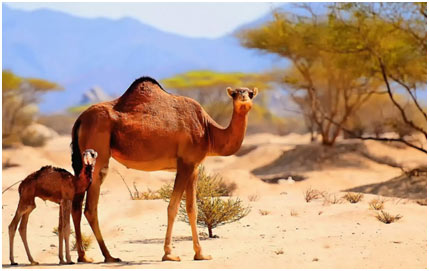Spellbinding Facts about Deserts
- The one-third surface of Earth consists of deserts and they are present in all seven continents.
- Deserts can be hot and cold.
- The world’s largest hot desert is the Sahara Desert in north Africa covering most of Algeria, Egypt, Libya.
- The world’s largest cold desert is the Antarctic also known as the polar desert.
- The world’s smallest desert is in Canada called the Carcross Desert.
- It is calculated that around one billion humans live in deserts of the world.
- There is no rain ever recorded in some parts of the Atacama Desert in Chile.
- The highest Earth surface temperature measured ever in the Sahara Desert.
The Desert Animals
Deserts are some of the harshest environments found in the world. Scorching temperature levels and water deficiency make it all but difficult for a lot of animals to live there. Deserts are places that don’t get much rain and are very dry.
They can be either hot places or cold places. Because deserts don’t have much water, animals that reside in the desert are able to conserve water and keep their body temperature at the right level. Here are a few well-known animals that reside in deserts.
1.Camel
Probably, camels are the very first image that comes to your mind when discussing wildlife in the Desert. They are essential for transportation, wool, milk, and meat. More importantly, camels are completely adapted to reside in harsh desert environments. The fat store hump is the most distinctive feature of camels.
There are both one-humped and two-humped camels. The camels likewise have the exceptional capability in the avoidance of water losses. They can stand up to up to 49 degrees Celsius without sweating. Therefore, camels avoid the loss of water in the form of evaporation.

The nose of camels has a big surface area with big turbinates. These turbinates save the body water by cools off the exhalant air. The blowing sands are one of the main troubles you need to deal with while moving across a desert. But for camels, it is not a problem. Since they have long eyelashes that secure against sand and severe sunlight.
2.Greater Roadrunner
Among the roadrunner body’s main methods to tackle water preservation is sure to simultaneously disgust and surprise the biologist. This animal uses water withdrawal and reabsorption from fecal waste. After consuming a meal, the roadrunner’s digestive system retrieves water from the bird’s feces as they sit in the excretory canals. Prior to removal, the water is withdrawn through this innovative, unappetizing, and peculiar physiological process, and only then the feces are expelled.

3.Deathstalker Scorpion
The deathstalker scorpion is one of the most poisonous animals discovered in scrublands and deserts. They have specialized adjustments to prosper in the hot desert land. The venom of the deathstalker scorpion is not deadly to a healthy adult human. But the sting is incredibly unpleasant and causes paralysis.

Even though the deathstalker scorpion features lots of adaptations, the regulation of metabolism is the most appreciable one. When the food is so scarce in the desert, the deathstalker scorpions will slow down their metabolism.
4.Skin-Drinking Desert Lizards
Scientific research study has shown that another, extremely ingenious, and biologically advanced approach of gathering water for internal rehydration has actually emerged amongst specific lizards. Through evaluation of Australian thorny devil and Texas horned lizard skin and scale structures, an unusual physiological adaptation has been discovered.

The skin of lizards prevents water loss and also keeps water from getting in through the skin, however, a novel method which lizard skin helps in accuracy water gathering has developed. Through this adaptation, the lizards are able to collect and then concentrate the water obtained from rainfall, damp sand, and swimming pools of water experienced on occasion.
5.Fennec Foxes
Fennec foxes populate the Saharan desert in Africa, where temperature levels average around 104 degrees Fahrenheit. Their big ears dispel heat by filtering blood through small capillaries in the thin ear tissue. Fennec Foxes have thick fur on the soles of their feet, which allows them to run over hot desert sand without pain.

While out and about during the night, fennec foxes delight in smaller desert animals, such as beetles and lizards.
6.Dung Beetles
There are numerous species of dung beetles, but most of them live in the deserts of Australia and Africa. Notoriously, these beetles feed solely on the dung of bigger animals. Though it may seem gross, consuming dung is a good choice for a little desert creature like a beetle. In the hot, dry desert, the wetness of any kind is hard to discover.

Dung contains moisture from the gut of the animal that expelled it. By consuming dung, they get all the advantages of the water found in by others without needing to do any of the work.
7.Desert Tortoise
The desert tortoise has a remarkable however strange physical adaptation that permits enhanced hydration management. This adaptation is available in the form of an extra-large bladder that can bring additional water.

In this specifically developed bladder, a desert tortoise can bring greater than 40 percent of its weight in urea, uric acid, nitrogen-based wastes, and water. With their thick rear legs and flatter front feet, desert tortoises have a much easier time strolling in the sand. Desert tortoises dig holes in the ground to catch rainwater before drinking and keeping the water in their bladders.

